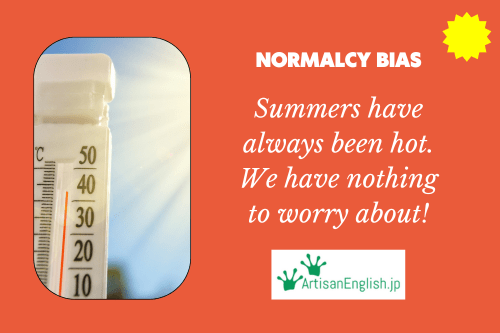
YouTube / iTunes / Spotify / Radio Public / Pocket Casts / Google Podcasts / Breaker / Overcast
Listen to ArtisanEnglish.jp posts & lesson intros here.
WotD: Normalcy bias
Normalcy bias is a cognitive bias that can lead people to underestimate the possibility of a disaster or crisis occurring.
This bias causes individuals to assume that things will always go according to plan and that the status quo will remain unchanged.
Essentially, normalcy bias is a tendency to believe that the future will be much like the present, regardless of any evidence to the contrary.
Normalcy bias can be dangerous because it can cause people to ignore or downplay warning signs of a potential crisis, leading to inadequate preparation and response.
It can also lead to a false sense of security, which can be shattered if a crisis does occur.
To avoid falling victim to normalcy bias, it is important to be aware of its existence and actively work to counteract it.
One way to do this is to seek information that challenges your assumptions and beliefs about the future.
This can involve reading news articles, speaking with experts, or engaging in scenario-planning exercises.
While you’re doing that, be on the lookout for confirmation bias.
Just because people are telling you what you want to hear doesn’t mean you should be listening.
Another way to avoid normalcy bias is staying grounded in the present moment and being open to the possibility that things may not always go according to plan.
For Japanese, this means learning from natural disasters that don’t affect them and adjusting their earthquake plans accordingly.
Just because you live in Tokyo doesn’t mean you won’t experience a Noto-like earthquake in which the government is slow to react, and you have to live on your own for weeks without help.
Social norms and peer pressure can reinforce normalcy bias.
People may be hesitant to discuss WWIII, the chances of an economic downturn, retirement planning, major natural disasters, or challenge the status quo for fear of being ostracized or ridiculed.
That’s them.
Don’t fall for normalcy bias.
You do what you need to do.
Flesch-Kincaid Readability Test
This post is understandable by someone with at least a 9th-grade education (age 15).
On the Flesch-Kincaid reading-ease test, this post scores 54.
The easier a passage is to read, the higher the score on a scale of 0 – 100.

